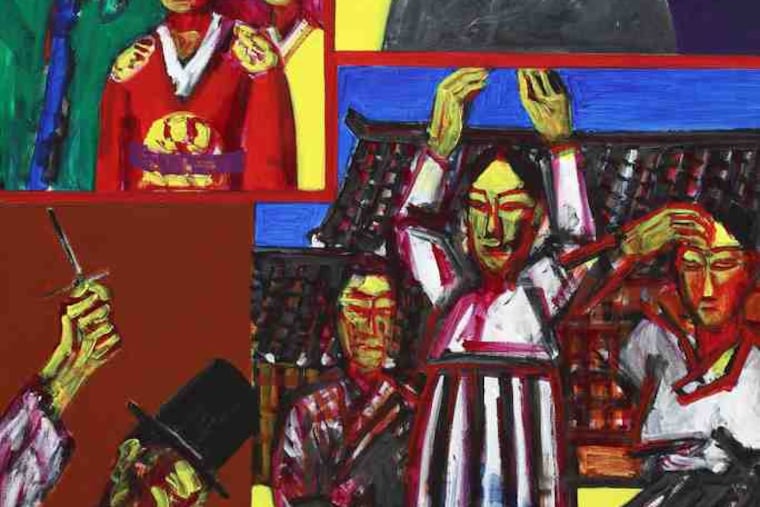Contemporary Korean art at Haverford gallery
The display "In and With: Contemporary Korean Art" at Haverford is up-to-date, has tonic quality, and doesn't genuflect before tradition. Yet technical process is never so assertive it intrudes upon the personal expression of these five artists. Two are active in Korea, while the other three have long resided outside their native land; much of their artwork reflects this.

The display "In and With: Contemporary Korean Art" at Haverford is up-to-date, has tonic quality, and doesn't genuflect before tradition. Yet technical process is never so assertive it intrudes upon the personal expression of these five artists. Two are active in Korea, while the other three have long resided outside their native land; much of their artwork reflects this.
In Oh Su Fan's paintings, a single twisting, spiky abstract shape hangs in the air like a dark splash against a flat plane of bright contrasting hue. Are these merely clever abstract-expressionist look-alikes? Hardly. The work of this calligrapher's son captures the spareness and economy of a Korean/Western style rooted in shamanistic spiritualism and Zen Buddhism.
Suh Yong Sun's visually compelling paintings offer a bold vision of recent history, colonialism, wartime occupation, and tensions between North and South Korea. The power of his work derives from his synthesis of drawing, painting and folk-art influences. Color loses itself in the figures or places represented, which draws us into examining each rugged painting carefully. Otherwise, the chief attraction is nonchalance, an informality that draws us in still further.
Juri Kim follows cultural practices, using a Korean tool to dip her paint. And her clear, crisp abstract style is the result of careful and delicate manipulation. Everything is accounted for down to the last detail, yet it isn't predictable. Kim is a master of an achingly exact technique.
But so is Yoo Bong Sang. This "nail artist" makes Korean landscape photos, turns them into digital prints, then creates an image on each, using thousands of carpenter's nails. Sang's broadly patterned, luminous, flat vacancies become "sculptural planes" and "flat sculptures" in a direct way without losing the mood to decorative detail. Is such a repertory of imagining his rediscovered links to the natural environment too limited to sustain itself?
Hee Sook Kim, the show's curator, displays big paper lithographic prints that movingly evoke a Korean way of life. Autobiography drives very little of her art, which, like an article of faith in the continuing vitality of Korea's rich traditions, resonates with veiled illusions, messages, and ancient memories.
A most memorable show.
Street talk
The exhibit "I Speak American," which supposedly tells how American ideals are shaping the global culture, is simply swamped with art made for the street. And that's too bad, because there's nothing sacred about art that belongs to the crowd, nothing that reflects American ideals.
This show, at Delaware County Community College in Media, was shortchanged regarding painting, sculpture, photography, and video that vigorously inform and reveal our humanist tradition. Instead, many of the participating regional artists in their 20s and 30s - whether American-born or not - are catering to a public appetite for whatever stimulates. Consequently, personality-starved work flourishes, its main attraction being its brassiness.
For example, one artist presents over-elaborated pink flamingos. A photographer portrays "faux" families and "faux" couples that consist of total strangers. Pop-oriented painting is a misfit here, as are multi-media images of the absurd. One artist shows video closeups of people blowing up balloons. A painter, seizing a familiar topic of the day, adroitly portrays people wearing masks and head scarfs.
Terry Adkins should be mentioned as an exhibiting artist who upholds American ideals using found objects. His banner of a public figure he admires is a forthright, direct piece. Another who seems to get the show's intended message is Egyptian artist Hamdi Attia, whose videos try to free his understanding of American culture from the simple duality of liberal vs. conservative, and in the process elevate his subjects. Still another builder-upper is theater artist/sculptor Leah Bailis who sets up a miniature "stage" of her own with small cardboard shelters.
Good times
"Celebrations," the group show currently at the Old City Jewish Art Center, features images and objects - dancers, weddings, menorahs - relating to intimate family festivities and community occasions for rejoicing found in Judaism.
They're a moving evocation of a way of life in Laurence Salzmann's and Jason Francisco's photographs from Philadelphia to Romania, Turkey, Ukraine, and Mexico, and in varied work by photographer/architect Constantin Kaducan of Romania, who came to the United States after the fall of communism in his homeland.
Ceramic sculptor Etta Winigrad displays her early Jewish ceremonial objects.